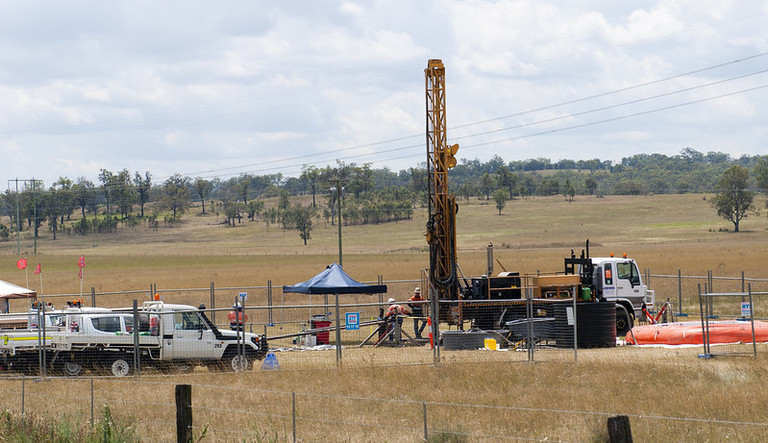Mineral exploration goes unchecked as demand escalates
Growing demands for ‘green’ minerals and metals are driving new mineral exploration at a pace and scale that we cannot ignore.


Exploratory drilling in Hunter Valley, Australia (Photo: Jeremy Buckingham, via Flickr, CC BY 2.0)
Increasing pressure to be more sustainable and more responsible is forcing business to rethink, reinvent and remarket the way it operates. In this shift towards greater sustainability, mining has found itself a comfortable seat at the ‘green growth’ table: a sector responsible for meeting the increased demands for ‘rare earth metals’ that underpin green technologies and infrastructure.
Even with its poor reputation, mining remains big business. Gold offers a “safe haven” in an economic downturn and diamonds continue to meet the aspirations of an ever growing global middle class.
But much attention, including new exploration, is now focused on cobalt, copper and lithium. These metals anticipate a ‘new commodity super cycle’ in response to green demands and supply constraints brought on by COVID-19.
Much hope is pinned on a ‘circular economy’ for the recycling and reuse of materials. But research shows that technical innovation alone cannot overcome the values and practices inherent to the capitalist system that are continuing to drive new mining exploration and development.
IIED’s new briefing paper explores how expansive mining exploration – whether for gold or ‘green growth’ metals – risks undermining sustainable development attempts to manage mining’s expanse and its unwanted impacts.
Mineral exploration is expansive
Mining needs land – land to explore, land to mine and land to support infrastructure. Within mining’s early ‘exploration’ phase, the operational footprint is small. However, the area under licence to explore is often huge.
For example, in Mongolia an exploration licence covering over 80,000 hectares of the southern Gobi region is hoping to uncover the world’s largest deposit of lithium. The lithium-ion battery remains at the forefront of battery technology.
Many mining countries have a cadastre that allow the public to view mining applications and licences. A review of these portals, many of which are available to view, is a sobering exercise.
- In Uganda mineral exploration licences currently cover around a quarter of the total land mass of Uganda including areas in the Virunga and Queen Elizabeth national parks
- Guinea’s eastern areas are almost entirely under gold mining and exploration and its western areas almost entirely bauxite – the main source of aluminium. Aluminium is marketed as 'green' as it can be recycled. But this claim is contradicted by this new exploration and mining, and
- In the Democratic Republic of Congo, a close-up of the south eastern Copperbelt region reveals the vast extent of industrial mining licenses that have left no space for creating much needed artisanal mining zones.
For mining companies, large areas increase the chances of identifying viable mineral resource that would be profitable to mine industrially. National governments are mostly in favour of this approach – keen to know the full extent of their countries’ mineral wealth.
These incentives are reflected in the policy and legal frameworks governing exploration. However, vague and inconsistent frameworks undermine the protections offered to local communities, the environment and, in some cases, even the national government.
Mineral exploration needs greater scrutiny
Theoretically, and often legally, any viable mineral deposit found within an exploration licence area could be mined.
In many countries, exploration licences give investors exclusive rights (PDF) without the level of safeguard that would apply to the full-scale development of a mine, such as environmental and social impact assessments (ESIAs) or free, prior and informed consent (FPIC).
Few countries require any form of community consultation at the exploration stage, and even fewer identify or enforce significant ‘no go’ areas for mining. Research shows that a significant amount of mining for green growth metals is taking place in and around protected areas.
In many cases, once a viable mineral resource is identified, the horse has already bolted. In the face of arguments for national economic interest, it can be hard for individual communities to protect their land rights or try and inform the design of the mine in line with their own priorities. ESIAs rarely identify alternative pathways for development (PDF) and investment approval systems become a tick-boxing exercise in the greenlighting of mine development.
Even a national government may lose its rights at this point of mineral exploration where an international tribunal might favour the ‘legitimate expectations’ of the investor and, perhaps inadvertently, further deny the rights and interests of local groups.
In the case of artisanal miners, exclusive exploration rights afforded to a large-scale mining company can mean they are immediately excluded from the land and their livelihood. And these informal miners often have no legal basis for defending their rights.
Exploring our options
The green transition won’t be truly green unless we recognise the contradictions posed by the mining sector. This includes challenging practices within licencing and exploration that fail to protect people and planet.
IIED, through its ALIGN programme (a partnership with the Columbia Center on Sustainable Investment (CCSI) and Namati) is offering technical advice to governments, civil society and local communities.
This includes how to bring better oversight and legal safeguards to mining, prior to and during mineral exploration, and ensure a fair balance of competing perspectives and incentives in decision-making, including those of the community and the environment.
ALIGN supports governments, civil society, local communities and other relevant actors in strengthening the governance of land-based investments. The project is implemented by a consortium led by IIED, the Columbia Center on Sustainable Investment (CCSI) and Namati, and is funded with UK aid from the UK government. This blog has been produced as part of ALIGN by IIED, however the views expressed do not necessarily reflect the official views or policies of ALIGN partners or the UK government.




